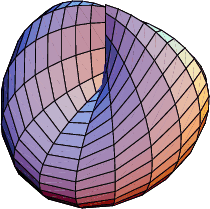|
|
|

The self-intersection of a one-sided Surface. It can be described as a circular Hole which, when entered, exits from its opposite point (from a topological viewpoint, both singular points on the cross-cap are equivalent). The cross-cap has a segment of double points which terminates at two ``Pinch Points'' known as Whitney Singularities.
The cross-cap can be generated using the general method for Nonorientable Surfaces using the polynomial function
| (1) |
| (2) | |||
| (3) | |||
| (4) |
Another representation is
| (5) |
| (6) | |||
| (7) | |||
| (8) |
| (9) |
| (10) |

Taking the inversion of a cross-cap such that (0, 0, ![]() ) is sent to
) is sent to ![]() gives a
Cylindroid, shown above (Pinkall 1986).
gives a
Cylindroid, shown above (Pinkall 1986).
The cross-cap is one of the three possible Surfaces obtained by sewing a Möbius Strip to the edge of a Disk. The other two are the Boy Surface and Roman Surface.
See also Boy Surface, Möbius Strip, Nonorientable Surface, Projective Plane, Roman Surface
References
Fischer, G. (Ed.). Plate 107 in
Mathematische Modelle/Mathematical Models, Bildband/Photograph Volume.
Braunschweig, Germany: Vieweg, p. 108, 1986.
Geometry Center. ``The Crosscap.''
http://www.geom.umn.edu/zoo/toptype/pplane/cap/.
Pinkall, U. Mathematical Models from the Collections of Universities and Museums (Ed. G. Fischer).
Braunschweig, Germany: Vieweg, p. 64, 1986.
|
|
|
© 1996-9 Eric W. Weisstein